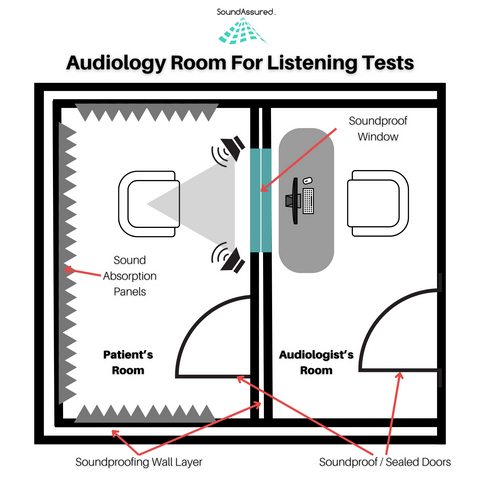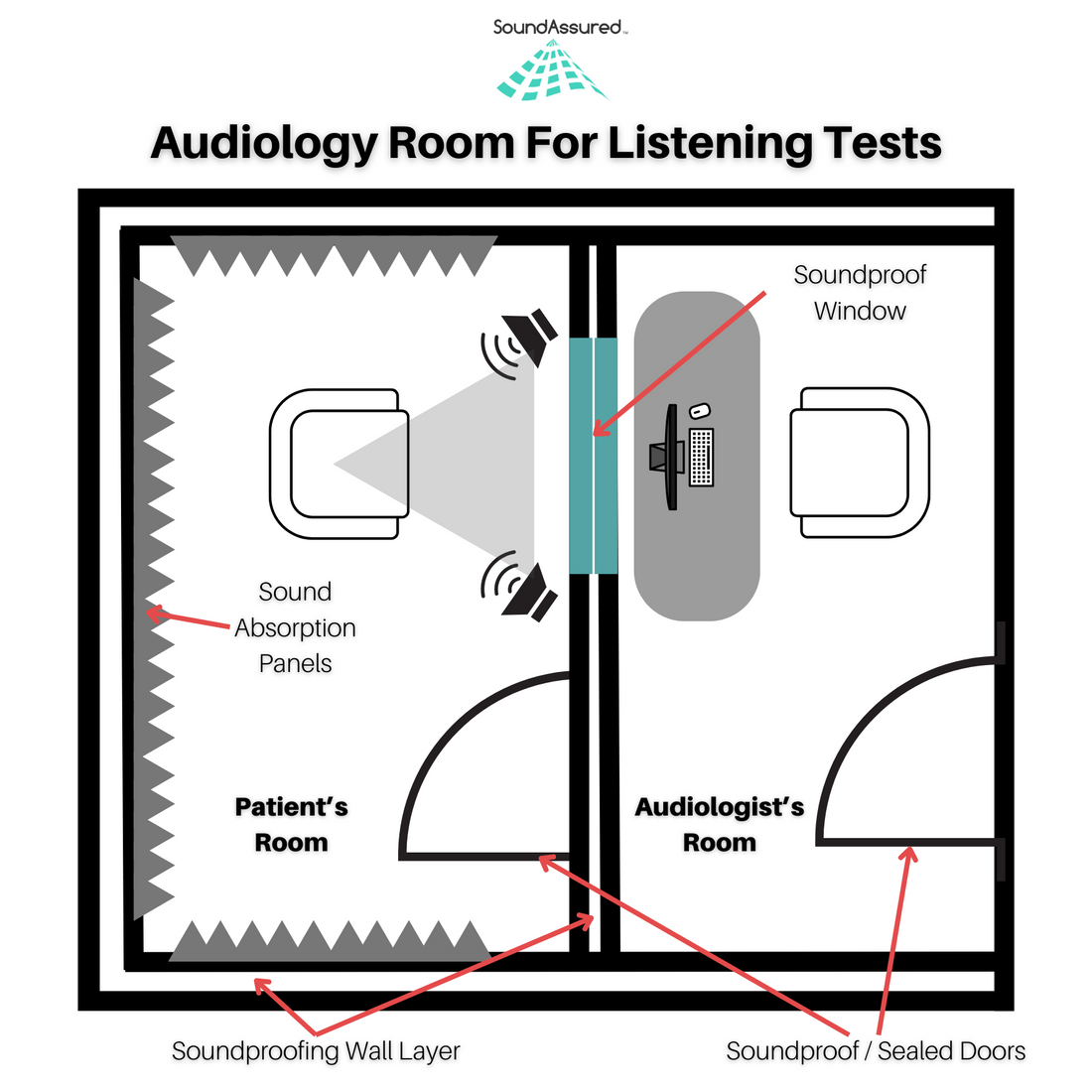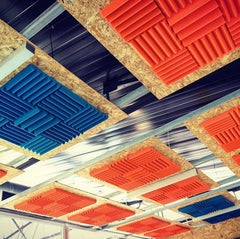Hearing tests are a cornerstone in diagnosing and managing hearing impairments. A crucial element in ensuring the tests' accuracy is the environment in which they are conducted. This post gets into the details of setting up listening rooms within a hearing clinic, delving in to essential considerations for creating an optimal testing environment.
The Basics of Listening Rooms
A listening room is specially designed within an audiology clinic to facilitate precise hearing assessments. These rooms are equipped with specific acoustic treatments and audio equipment to create a controlled auditory environment.
Below is an example of a room built inside an audiology office specifically designed to administer hearing tests.

The room is divided into two main areas: the patient's room and the audiologist's room, separated by a soundproof wall layer. The patient's room is outfitted with sound absorption panels on the walls to dampen echoes and reduce ambient noise, ensuring a controlled testing environment.
The audiologist's room includes a work area equipped with the necessary testing equipment and an observation window to monitor the patient. This soundproof window allows the audiologist to observe the patient without affecting the sound conditions within the testing space.
Both rooms are accessible through soundproof or sealed doors, maintaining the integrity of the sound environment and preventing external noise from entering the testing area. The layout is designed to optimize the quality of the listening tests and ensure accurate results.
Planning and Design
Room Selection
Choosing the right room involves considering its size, location within the clinic, and potential for soundproofing. A quiet, isolated part of the clinic is ideal to minimize external noise interference.
Soundproofing Techniques
Soundproofing is critical to shield the room from external sounds. Techniques include installing wall insulation, constructing double walls, and using sound-blocking materials to ensure a noise-controlled environment.
Below is an image that shows some soundproofing techniques for walls. You can check out our soundproofing materials here.

Acoustic Treatment
Acoustic treatment is a crucial component in designing an audiology testing room, going hand-in-hand with soundproofing to enhance the internal auditory environment. It involves the strategic placement of various elements that work together to control sound waves within the room.
Bass traps are installed in room corners to absorb low-frequency sounds, which are typically harder to dampen and can otherwise unduly reverberate, muddying the test sounds.
Acoustic absorption panels are attached to walls and sometimes ceilings; they are designed to capture mid to high-frequency sound waves, further preventing reverberation and echo. These tiles are often made of porous materials like foam or fiberglass which absorb sound energy rather than reflecting it. This treatment maintains a neutral sound environment, which is critical for the accurate measurement of a patient's hearing capabilities.
The goal of acoustic treatment is to create a room with a balanced sound profile, eliminating or minimizing all unwanted acoustic effects. This not only ensures clarity for the sounds used during tests but also helps in creating a comfortable and focused environment for patients.
A well-acoustically treated room responds predictably to sound, making it possible to conduct various types of hearing tests with precision. In addition to these measures, the treatment may include adjustable elements that can be modified according to the specific requirements of different types of auditory examinations, thereby providing a versatile environment suitable for comprehensive audiological evaluations.
When considering acoustic treatments for an audiology testing room, one should look for high-quality materials that will effectively manage sound reflections and reverberations. Here are some product recommendations and DIY solutions to achieve an optimal sound environment:
-
SoundAssured Acoustic Foam Panels: These are an excellent choice for mid to high-frequency sound absorption. SoundAssured panels are known for their easy installation and ability to reduce unwanted noise and echo, creating a clearer auditory space. They can be strategically placed on walls and ceilings where sound reflections are likely to occur.
-
Acoustic Foam Corner Bass Traps: Corner bass traps from reputable suppliers like SoundAssured can significantly enhance the room's acoustic profile by absorbing the difficult-to-manage low frequencies that tend to accumulate in room corners. They're essential for a fully balanced sound environment and are crucial for maintaining the accuracy of hearing assessments.
-
DIY Acoustic Panels: For a cost-effective and customizable option, creating DIY acoustic panels with fabric and insulation materials can be an effective solution. Using rigid fiberglass insulation boards covered with acoustically transparent fabric, these panels can be tailor-made to fit specific areas within the room. This approach allows for the selection of fabrics that can complement the room's design while providing functional sound absorption.
Do you need diffusers?
One common questions we hear is, "How do I know if I need diffusers in the room?" Diffusers are an acoustical panel designed to scatter sound waves rather than reflect them, and they leave more sound energy or "liveliness" in the room.
In audiology hearing test rooms, diffusers are generally not necessary as the focus is on creating a quiet, non-reverberant environment to accurately assess a patient's hearing. The goal is to minimize all forms of sound reflection and interference, which is typically achieved through the use of sound absorption materials rather than diffusers. Hence, diffusers are often skipped in these settings in favor of materials that will deaden the space and prevent echoes, ensuring the purity of test tones and speech stimuli.
Equipment and Technology
Audiometric Equipment
The backbone of a listening room is its audiometric equipment, including audiometers and specialized headphones. This equipment must be carefully selected and maintained to ensure precision in hearing assessments.
Speaker Placement
In an audiology testing room, the placement of speakers is critical to the accuracy and effectiveness of auditory evaluations.
Number of Speakers: Depending on the test, a listening room may have two speakers for stereo tests or multiple speakers for surround sound tests (e.g., 5.1 or 7.1 surround systems for spatial hearing tests).
Placement: Speakers are placed at ear level when the patient is seated. For more advanced spatial hearing tests, speakers may also be placed at different elevations to test the patient's ability to perceive sounds from different vertical angles.
Orientation: The speakers should be oriented directly towards the position where the patient's head will be during the test. This ensures that the sound travels directly from the speaker to the patient's ears without reflections.
Equal Distance: In a multi-speaker setup, it is ideal for each speaker to be equidistant from the patient to maintain a balanced sound field.
Calibration: Each speaker must be carefully calibrated to ensure that they all produce sound at the same volume level when a signal of identical intensity is played.
Absence of Obstructions: The path between the speakers and the patient's ears should be free of obstructions to prevent sound distortion or diffraction.
Room Acoustics: The room's acoustics should be designed to minimize echo and reverb, which can be achieved with the use of acoustic panels and diffusers. This helps in preserving the purity of the test tones.
Sound Field Testing: For sound field testing, where hearing aids or cochlear implants are evaluated, the speakers must be positioned according to specific standards (like ANSI or ISO) which dictate the angles and distances for speaker placement relative to the patient.
Noise Control: The room should be soundproofed to prevent external noise from affecting the test results.
The specific standards and protocols for speaker placement may vary depending on the type of hearing test being conducted, as well as the size and shape of the testing room. It is important that audiologists follow these standards to ensure the reliability and accuracy of the hearing assessments.
Calibration
Regular calibration of audio equipment is essential to maintain test accuracy. This process involves adjusting the equipment to meet standardized output levels, ensuring consistent test results over time.
Comfort and Accessibility
Seating and Lighting
The listening room should offer comfortable seating and adjustable lighting to accommodate patients' needs and preferences, creating a relaxed environment conducive to accurate testing.
Accessibility
Accessibility features are crucial to accommodate patients with disabilities, ensuring that the listening room is welcoming and accessible to everyone.
Compliance and Standards
Regulatory Requirements
Listening rooms must adhere to specific regulatory standards, such as those set by ANSI or ISO. These regulations cover aspects from acoustic conditions to equipment specifications.
Certification
Achieving certification for the listening room involves a formal process of meeting prescribed standards, reinforcing the clinic's commitment to providing high-quality hearing assessments.
Maintenance and Upkeep
Routine Checks
Regular maintenance of both the acoustic environment and the testing equipment is vital to prevent issues that could affect test accuracy, such as sound leakage or equipment malfunction.
Troubleshooting Common Issues
Clinics should be prepared to address common problems promptly, ensuring the listening room remains a reliable environment for hearing assessments.
Need more help? Don't worry, we are here for you!
Full line of acoustic foam!
Check out more acoustic foam panels and corner solutions!













